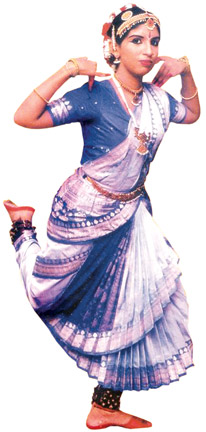Choreography is a separate art
Subashini PATHMANATHAN
|

Choreography should be handled with mastery
|
| Choreographer’s
role |
Should be familiar with the
nuances of the dance
Interweaves the adavus with appropriate abhinayas
Must maintain traditions of the art
Handles all the nirthiya such as bhava and rasas |
Choreography is a unique art. In any dance form, whether it is a
classical or folk, choreography is an exceptional talent for the
artiste. Not all performing artistes are good choreographers, nor all
good performers are good choreographers. To be a successful
choreographer, one has to have a long association with the art with an
intense involvement in the development and wide practical experience,
total dedication and devotion to the art.
In the classical dance forms the choreographers must know the nuances
of the dance properly. They must know the nuances of thala, kala (degree
of speed or tempo) and laya. They must interweave the adavus, with
appropriate abhinayas and must possess an intimate knowledge of the
technical aspects of the adavus. In addition, the successful
choreographer has to have the ability to weave the different poses
together with appropriate dances and should be able to synthesize the
thala, kala and laya with the accompaniments.
The choreographer must have wide experience and deep knowledge in
this traditional art form. However, unfortunately the present
choreographers are induced by very superficial level, and they forecast
colourful and entertainment programs, rather than forecasting the
traditional important aspects. The present choreographers believe that
they must be able to gauge the moods of the audience, and try to reflect
the moods of the audience according to their modern trends and moods.
The choreographer must maintain certain traditional standards in this
art. But unfortunately many present so called choreographers are
adopting numerous techniques of their own which have little relevance to
the theme intended to be expounded.
|

Every movement is important in classical dancing |
Besides, the choreographer must have the full ability to handle all
the nirthiya such as bhava (expressions), rasas (essence) and abinaya
elements with dexterity, and combined with various nirtha aspects.
The main nirthiya elements are abinaya, bhava and rasa. The meaning
of the song should be expounded through bhava, rasa and appropriate
abinaya through hand gestures.
The innovations introduced by the choreographers of the modern era in
the dance field will hamper the development of pure choreography of
traditional dance in future.
The choreographer must be one, capable of explaining the newly
adopted techniques and its relevance to their classical basis. Classical
music is the soul of the classical dance and thala is the soul of the
classical music.
Therefore, the choreographer must have a thorough knowledge of music
and thala.
In Classical Bharatha Natyam, generally Nattuvangam coordinates the
dance by thala (cymbals) with vocal music and other accompaniments. In
addition, the oral nattuvangam, the nattuvanga jathis (nattuvanga
sollukadus or oral nattuvanga words) are combined with pure nirtha
adavus with thala cymbals. The nattuvanga sollukadus must coordinate
with thala, in which the music is compiled. Oral jathi nattuvangam are
delightful and vibrant combination of sollukadus (words). According to
puranic stories, these nattuvanga jathis had their origin from Lord
Siva's five faces when he performs five important functions in five
thandavas.
Such functions are namely creation, protection, (in two thandavas)
bestow happiness, and protection from sorrow, destruction, dispelling
egoism, sin, illusion, and bestow of blessings. The five functions of
Lord Siva are collectively called pancha kiruthiya thollil. These five
nattuvanga jathis are thath, thee, thom, namm and jamm.
Hence, the oral nattuvanga jathis are generally based on these five
above said sounds. In choreography, attention should be paid to thala
and kala (degree of speed or tempo). The relationship between thala and
kala must be evenly balanced, and this is called laya.
Laya vinniyasam is often used in the nattuvangam or in the oral
nattuvanga jathis or in the swara jathis or in the thirmana adavus
(sequence of adavus at the end of each paragraph), or in the sakithiya
verses.
Laya vinnitasam is closely linked to Thala and Kala (degree of speed
or tempo). The excellence of a production depends upon the ability of
the choreographer as well as the excellence of the artistes.
The classical dance recitals totally imbibe with deep philosophy,
long history, and religion. Yet the present dance teachers
(choreographers) do not bother to stick to the tradition much, but trade
the dance forms, under the name of certain classical dance form, and
they do not stick to the classical format, and standards. Their only aim
is try to impress the event successfully, by using numerous
technologies, and colourful entertainment shows. |



